Le vendredi 17 novembre 2023, l'INSA Strasbourg a été le théâtre d'un événement exceptionnel concernant la pédagogie de l'architecture. Organisé par la spécialité architecture de l'INSA Strasbourg, dans le cadre de l'atelier de conception architecturale destiné aux étudiant.e.s en 4ème année d'architecture et d'ingénierie (AI4), intitulé "hétérotopies climatiques", et dans le cadre du MOOC (Cours en ligne ouvert et massif) e-CREHA (Éducation pour le patrimoine architectural européen résilient au climat) cet événement avait comme objectif de captiver l'imagination et de stimuler la réflexion autour de l'interconnexion entre la musique, la poésie, les mots et l'architecture. La présence illustre du compositeur, auteur et interprète de renommée internationale, Alkinoos Ioannides, a marqué cette journée mémorable.
Au cœur de cette journée thématique se trouvait la présence d’Alkinoos Ioannides, compositeur, auteur et interprète de renommée mondiale. Son caractère sui generis a enrichi les discussions et les performances, offrant une perspective nouvelle sur la manière dont la création musicale peut dialoguer avec l’acte de la conception architecturale et les concepts spatiaux.
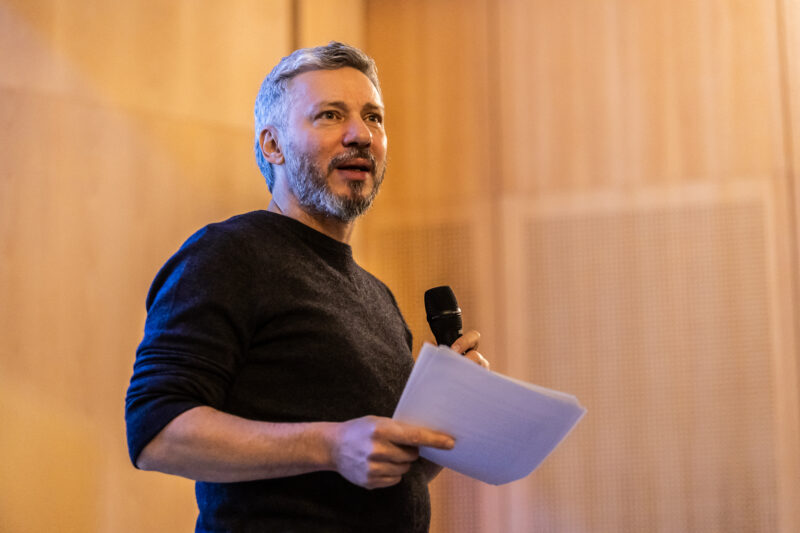
Les participants ont été invités à explorer les liens subtils et puissants entre ces disciplines apparemment distinctes, découvrant comment la musique, le son et les mots peuvent influencer la perception de la conception de l’espace et vice versa. Des moments de dialogue socratique entre Lazaros Mavromatidis, architecte-ingénieur docteur et Habilité à diriger des recherches (HDR), enseignant-chercheur à l’INSA Strasbourg et coordinateur de la spécialité architecture, Alkinoos Ioannides et les étudiant.e.s ont enrichi cette exploration, ouvrant des horizons créatifs et intellectuels.
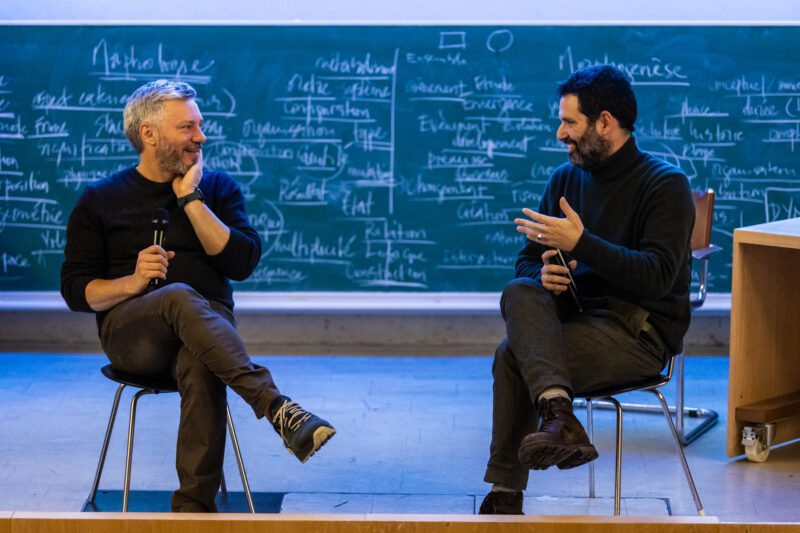
Alkinoos Ioannides a illustré lors de sa conférence que la chanson dépasse la simple combinaison de mots et de notes pour devenir une forme d’expression où les mots se transforment en son et où les notes portent un sens profond. Cette forme artistique établit un dialogue constant entre tradition et innovation, agissant comme une structure architecturale qui relie le passé et le futur. Tout comme un projet architectural, la chanson est conçue avec une attention minutieuse aux détails et à la structure.
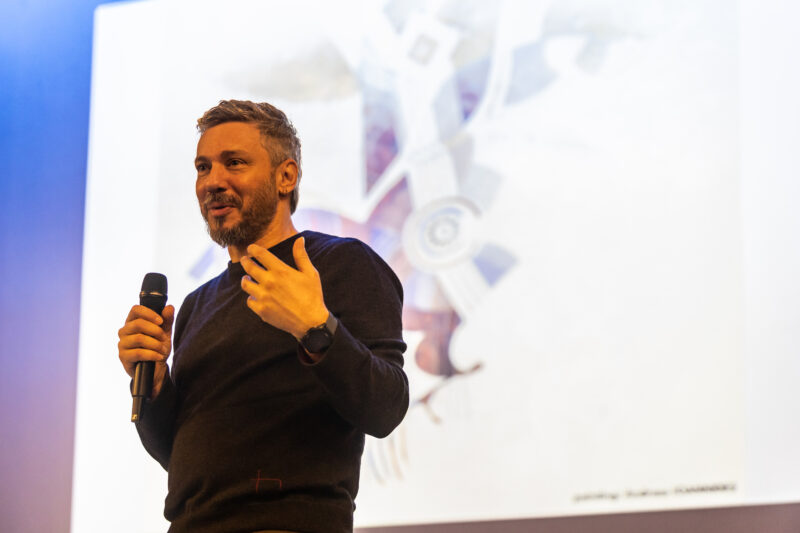
Les paroles, comme les matériaux de construction, sont soigneusement choisies pour transmettre une émotion particulière ou raconter une histoire spécifique. Les notes musicales, telles que les éléments architecturaux, sont disposées de manière à soutenir et à renforcer le contenu émotionnel de la chanson. La poésie, qu’elle soit chantée ou non, conserve une puissance émotionnelle captivante, comparable à l’impact esthétique et émotionnel d’une architecture bien conçue. Lorsqu’on lit des paroles écrites, on peut souvent percevoir une mélodie subtile cachée en leur dessein, comme si une partition musicale était intégrée dans la structure même des mots.
Ensuite Alkinoos Ioannides a démontré que la chanson, tout comme une œuvre architecturale, reflète non seulement l’époque dont elle émane, mais elle transcende également les barrières temporelles en capturant en quelques minutes l’essence émotionnelle et narrative de plusieurs siècles. Comme une structure architecturale qui définit et transforme l’environnement physique, la chanson influence profondément notre expérience quotidienne et notre perception du monde qui nous entoure. En s’appuyant sur cette position théorique, il a souligné que l’analyse de la chanson à travers une lentille « architecturale » met en lumière sa complexité et son impact durable, enrichissant notre compréhension de cette forme d’art omniprésente et puissante.
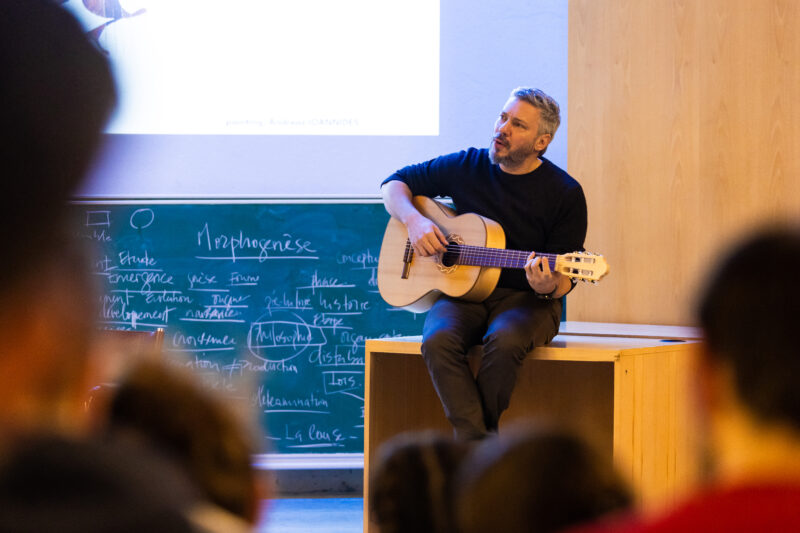
Alkinoos Ioannides en interprétant la chanson « Le Pèlerin » (« o προσκυνητής »).
Sur ce point, Lazaros Mavromatidis a introduit sa conférence en affirmant que ce mécanisme perceptif rappelle la manière dont les dessins d’architecture peuvent révéler des détails cachés ou des intentions artistiques sous-jacentes, menant ainsi à une reproduction créative de l’architecture. Les dessins architecturaux, tout comme les partitions musicales et les poèmes, sont des vecteurs de communication essentiels, mais ne constituent pas l’œuvre d’art en tant que telle. Ils transmettent des informations et ouvrent un espace d’interprétation phénoménologique, ce qui est au cœur de l’acte de conception. Pour illustrer ceci, il a utilisé l’exemple de l’évolution des doigtés de guitare dans la musique contemporaine, et comment les nouvelles techniques peuvent influencer l’interprétation des archetypes musicaux. Cette comparaison a mis en lumière comment des techniques modernes peuvent enrichir et transformer la manière d’aborder des œuvres classiques, en révélant de nouvelles perspectives et en ajoutant de la profondeur à l’interprétation musicale. il a ainsi démontré que, tout comme en architecture, où les plans peuvent dévoiler des éléments invisibles à première vue, la musique et ses techniques peuvent également révéler des couches cachées et des intentions artistiques, enrichissant notre compréhension et notre appréciation des œuvres.

Lazaros Mavromatidis compare les doigtés de « Fade to Black » de Metallica avec une doigté alternative pour la « BWV 995 Gavotte I & II » de Johann Sebastian Bach pour luth, pour illustrer comment différentes approches influencent sonorement et esthétiquement une œuvre musicale classique.
La conférence de Lazaros Mavromatidis, a d’ailleurs exposé plusieurs réflexions profondes qui ont émergé sur la manière dont nous concevons et expérimentons les espaces architecturaux. il a posé des questions cruciales sur la capacité de concevoir méticuleusement un sentiment d’immersion profonde à travers le médium auditif. Il a exploré comment les rencontres synesthésiques et l’interaction complexe des perceptions auditives contribuent à la formation de notre imagination spatiale complexe. Il a également examiné les dimensions nuancées du silence, le contemplant philosophiquement en tant qu’élément architectural fondamental. Il a questionné comment un architecte pourrait habilement démêler le concept énigmatique de « l’oreille architecturale » pour construire un lieu profondément évocateur. Un autre point clé de sa conférence portait sur la tradition pédagogique des architectes qui consiste à concevoir des éléments spatiaux principalement ancrés dans l’imagerie visuelle. Il a mis en avant le potentiel d’une approche plus multisensorielle de la conception architecturale, qui transcenderait ce paradigme conventionnel en intégrant davantage le son dans le processus de création.
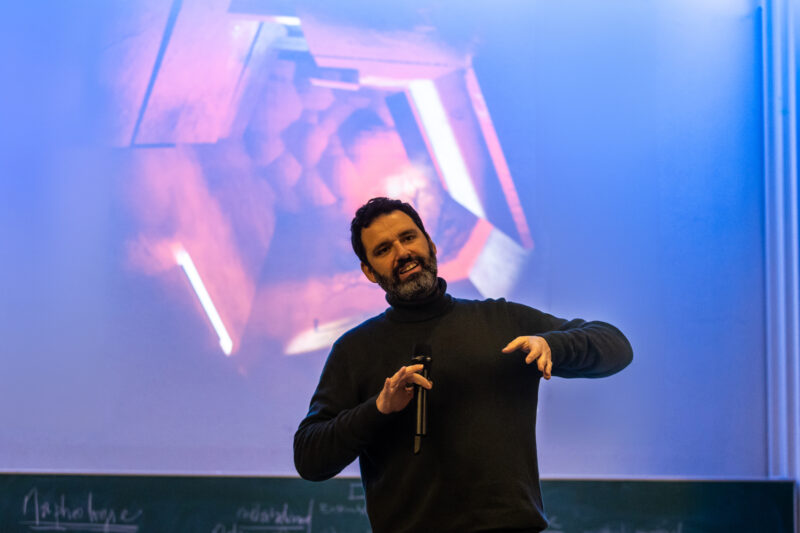
Lazaros Mavromatidis a affirmé que l’essence de l’exploration architecturale réside dans la convergence de ces questions : il ne s’agit pas seulement de délimiter des espaces, mais d’orchestrer un opus multisensoriel qui résonne au cœur de la conscience environnementale. C’est au sein de cette interaction de modalités sensorielles que l’architecture d’une résonance exceptionnelle se manifeste à travers les siècles. Cette deuxième conférence a ainsi offert une perspective enrichissante sur l’intégration des perceptions auditives dans l’architecture, incitant les participants à envisager des méthodes de conception qui favorisent une expérience spatiale plus immersive et multisensorielle.
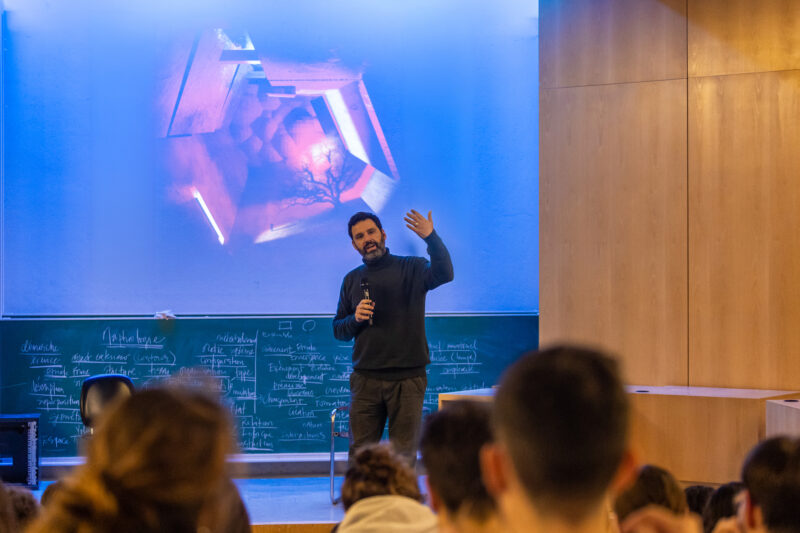
Pour aller au-delà d’une simple démonstration théorique, Lazaros Mavromatidis a mis en place une expérimentation pédagogique innovante. Il a composé la musique et a créé un support auditif spécialement conçu pour accompagner la narration d’un extrait classique de « Les Villes invisibles » de l’écrivain italien Italo Calvino. Ensuite, il a demandé aux étudiant.e.s de fermer leurs yeux et, sans recourir à la perception visuelle, de concevoir un espace uniquement en se laissant guider par la combinaison des sons, des notes et des mots du support auditif.
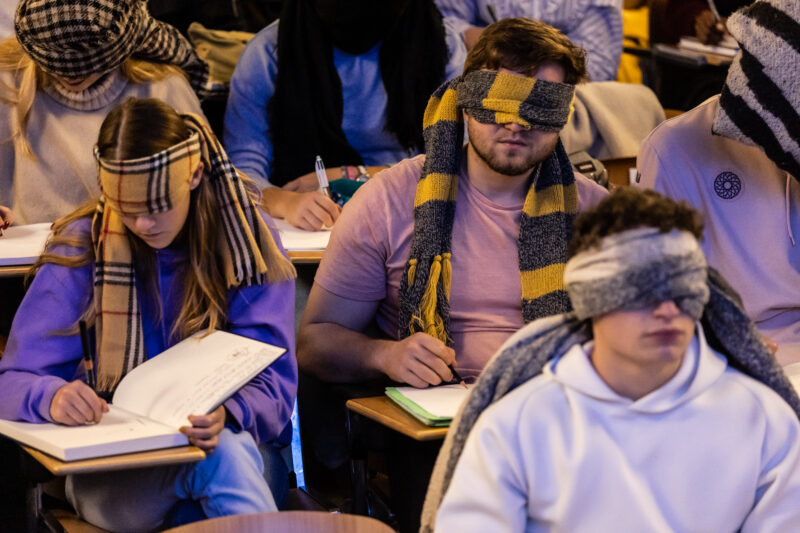
Cette expérience a concrétisé les concepts théoriques abordés lors de cette journée thématique, en stimulant l’imaginaire des étudiant.e.s. Elle a démontré aux étudiant.e.s de manière tangible comment les perceptions auditives peuvent enrichir la conception spatiale, encourageant les futurs architectes à intégrer des qualités spatiales multidimensionnelles dans leurs projets. Ce procédé a non seulement illustré le potentiel de l’audio dans la création architecturale, mais a également permis aux participant.e.s de vivre une immersion totale, en leur offrant une nouvelle perspective sur la manière de percevoir et de concevoir des espaces.
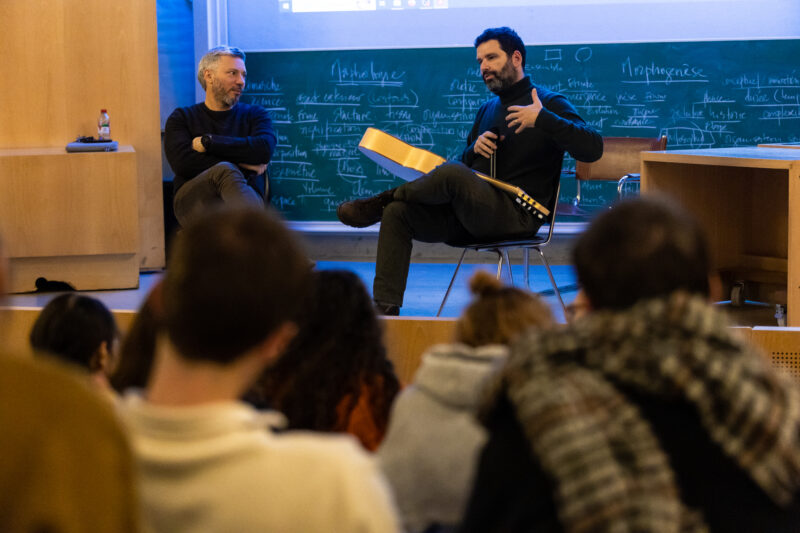
Cette approche pédagogique a ainsi montré comment les sons et les mots peuvent profondément influencer et inspirer les qualités architecturales, dépassant les limites de la perception visuelle conventionnelle.
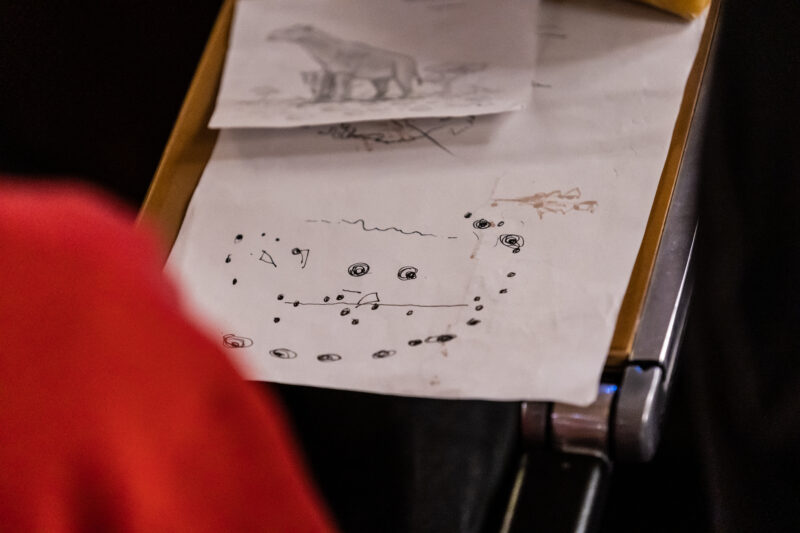 Ensuite, les deux intervenants ont conduit un atelier de conception architecturale, durant lequel ils ont discuté en profondeur des projets des étudiant.e.s. Ils ont partagé leurs perspectives et offert des conseils pratiques, encourageant les étudiant.e.s à intégrer les concepts abordés dans leurs propres travaux. La journée s’est clôturée par une session d’accompagnement, où Lazaros Mavromatidis et Alkinoos Ioannides ont aidé les étudiant.e.s à développer et affiner leurs projets, mettant en pratique les idées explorées pendant cette journée thématique.
Ensuite, les deux intervenants ont conduit un atelier de conception architecturale, durant lequel ils ont discuté en profondeur des projets des étudiant.e.s. Ils ont partagé leurs perspectives et offert des conseils pratiques, encourageant les étudiant.e.s à intégrer les concepts abordés dans leurs propres travaux. La journée s’est clôturée par une session d’accompagnement, où Lazaros Mavromatidis et Alkinoos Ioannides ont aidé les étudiant.e.s à développer et affiner leurs projets, mettant en pratique les idées explorées pendant cette journée thématique.
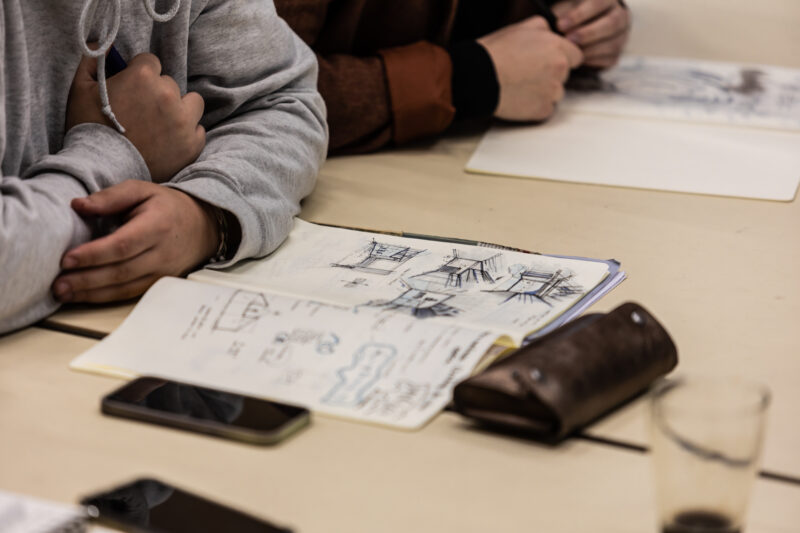
Cette approche a permis aux étudiant.e.s de bénéficier d’un encadrement personnalisé et de transformer leurs visions théoriques en réalisations concrètes. L’atelier a également fourni une plateforme pour des échanges constructifs, renforçant la compréhension et l’application des concepts de design multisensoriel dans l’architecture.

La journée s’est avérée être une expérience enrichissante, intégrant théorie et pratique, et laissant les étudiant.e.s inspiré.e.s et mieux équipé.e.s pour aborder leurs futurs projets architecturaux avec une perspective plus holistique et innovante.
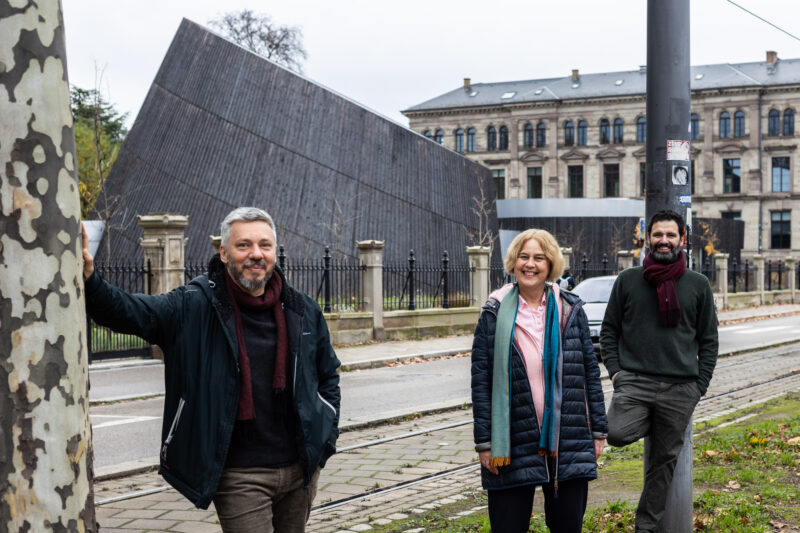
De gauche à droite : Alkinoos Ioannides, Angelika Hammann, directrice du Service des relations internationales et Lazaros Mavromatidis.
À PROPOS DE NOTRE INVITÉ

Alkinoos Ioannides
Alkinoos Ioannides, né à Nicosie, Chypre, est un auteur-compositeur- interprète distingué. Il a étudié la guitare classique au Conservatoire Européen avant de déménager à Athènes en 1989, où il a étudié le théâtre et la philosophie. En signant avec Universal Music en 1993, Ioannides a sorti onze albums solo, dont plusieurs ont atteint le statut d’or ou de platine, et a collaboré sur plus de 40 albums. Ses influences musicales diversifiées comprennent la musique traditionnelle chypriote, byzantine, classique, rock et les compositeurs grecs. Ioannides se produit avec un groupe ou en solo, intégrant des influences rock, jazz, classique, grecque et moyen-orientale dans ses spectacles, qui se déroulent dans des lieux allant des amphithéâtres antiques aux scènes de rock modernes. Il a étudié la composition avec le compositeur russe Boris Tishchenko et ses œuvres symphoniques ont été interprétées par des orchestres prestigieux à l’échelle mondiale. Son travail théâtral comprend des rôles principaux au théâtre antique d’Épidaure et des compositions pour le théâtre dans plusieurs pays. Ioannides se produit également avec le groupe d’avant-garde FMS et a siègé au conseil d’administration du Megaron d’Athènes. Il donne des séminaires annuels d’écriture créative et a donné plus de 1 700 concerts en Grèce et à Chypre, et 100 à l’étranger.

NB: Toutes les photos ont été réalisées par l’architecte-photographe Michel Grasso. Il est formellement interdit d’utiliser, de partager ou de diffuser des photos de cet événement sans l’autorisation explicite du photographe et des personnes figurant sur les photos. Cela comprend, sans s’y limiter, toute reproduction numérique ou physique, publication ou partage public sur quelque plateforme que ce soit. Le respect du droit des individus sur leur propre image et des droits créatifs du photographe revêt une importance primordiale pour l’École d’Architecture de l’INSA Strasbourg, et toute utilisation non autorisée sera considérée comme une violation de la vie privée et du droit d’auteur. L’autorisation doit être sollicitée et accordée par toutes les parties concernées avant toute utilisation de ces photos.
_____________________________________________________________________________________________________________
(English Version)
Thematic Days – Aetherotopias (3/8): Workshop « Exploration Beyond Notes, Words, and Architectural Spaces, » Retrospective

On Friday, November 17, 2023, INSA Strasbourg was the setting for an exceptional event concerning the pedagogy of architecture. Organized by the architecture specialty of INSA Strasbourg, within the framework of the architectural design workshop for fourth-year Architecture and Engineering (AI4) students, titled « climatic heterotopias, » and as part of the MOOC (Massive Open Online Course) e-CREHA (Education for Climate-Resilient European Architectural Heritage), this event captivated the imagination and stimulated reflection on the interconnection between music, poetry, words, and architecture. The illustrious presence of internationally renowned composer, author, and performer Alkinoos Ioannides marked this memorable day.
At the heart of this thematic day was the presence of Alkinoos Ioannides, a world-renowned composer, author, and performer. His unique character enriched the discussions and performances, offering a fresh perspective on how musical creation can interact with architectural design and spatial concepts.
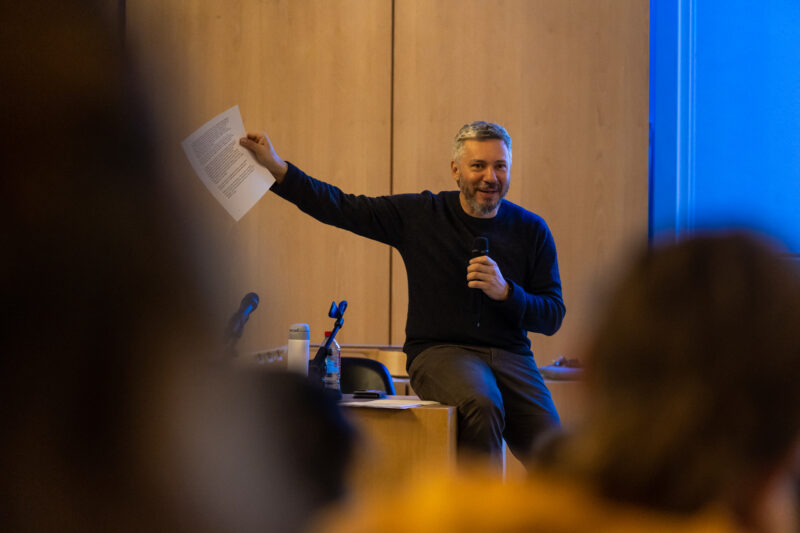
Participants were invited to explore the subtle and powerful connections between these seemingly distinct disciplines, discovering how music, sound, and words can influence the perception of space design and vice versa. The socratic dialogue between Lazaros Mavromatidis, PhD & HDR architect-engineer, Associate Professor at INSA Strasbourg, and coordinator of the architecture specialty, Alkinoos Ioannides, and the students enriched this exploration, opening creative and intellectual horizons.
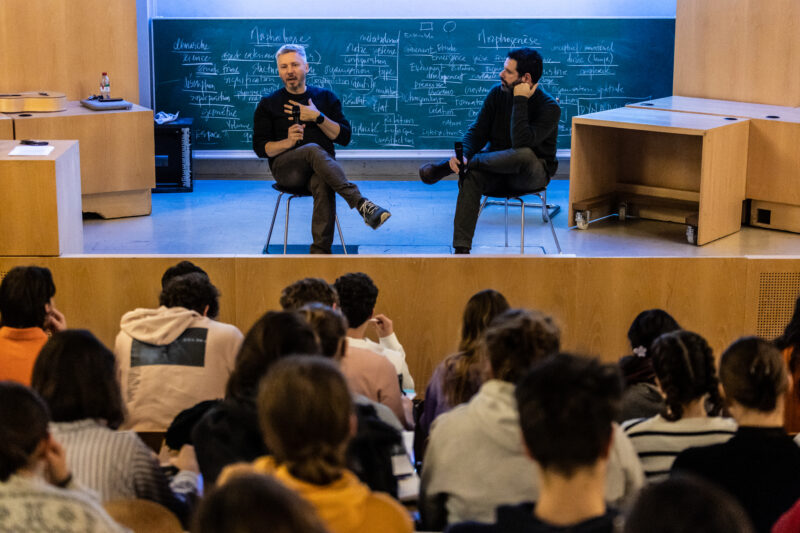
Alkinoos Ioannides illustrated during his lecture that a song goes beyond the mere combination of words and notes to become a form of expression where words transform into sounds and notes and carry profound meaning. This art form establishes a constant dialogue between tradition and innovation, acting like an architectural structure that links the past and the future. Like an architectural project, a song is crafted with meticulous attention to details and structure. The lyrics, akin to building materials, are carefully chosen to convey a particular emotion or tell a specific story. Musical notes, like architectural elements, are arranged to support and enhance the song’s emotional content.
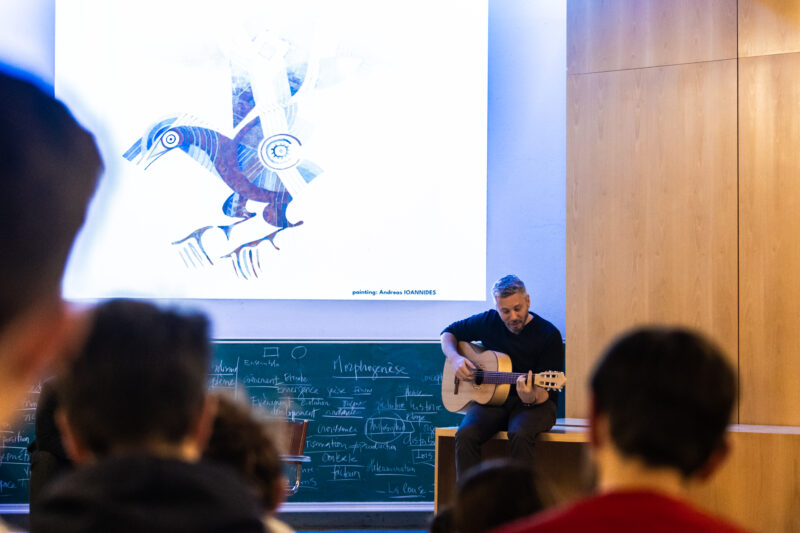
Alkinoos Ioannides performing his song « The Pilgrim. »
Poetry, whether sung or not, retains a captivating emotional power, comparable to the aesthetic and emotional impact of well-designed architecture. When reading written lyrics, one can often perceive a subtle melody hidden in their design, as if a musical score were embedded within the words themselves.
Then, Alkinoos Ioannides demonstrated that a song, like an architectural work, reflects not only the era from which it originates but also transcends temporal barriers by capturing in a few minutes the emotional and narrative essence of several centuries. Like an architectural structure that defines and transforms the physical environment, a song profoundly influences our daily experience and perception of the world around us. Based on this theoretical position, he emphasized that analyzing a song through an « architectural » lens highlights its complexity and lasting impact, enriching our understanding of this ubiquitous and powerful art form.
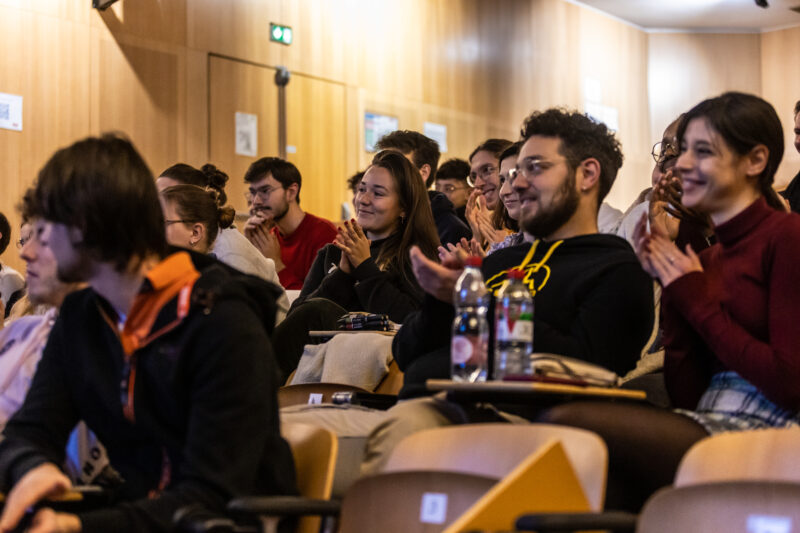
On this point, Lazaros Mavromatidis introduced his lecture by affirming that this perceptual mechanism recalls how architectural drawings can reveal hidden details or underlying artistic intentions, leading to a creative reproduction of architecture that evolves over time. Architectural drawings, like musical scores and poems, are essential communication vectors but do not constitute the artwork itself. They convey information and open a space for phenomenological interpretation, which lies at the heart of the act of design.
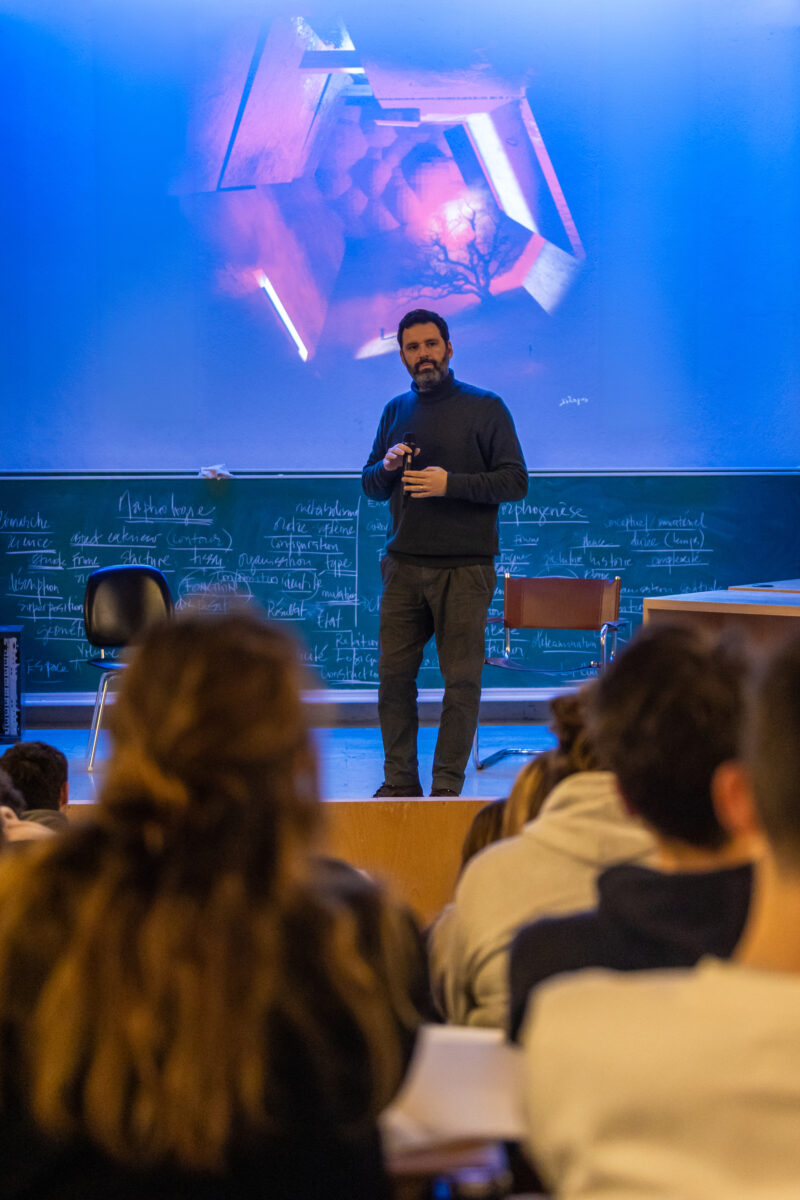
To illustrate this in a direct concrete way, Lazaros Mavromatidis used the example of the evolution of guitar fingerings in contemporary music and how new techniques can influence the interpretation of musical archetypes. This comparison highlighted how modern techniques can enrich and transform the approach to classical works, revealing new perspectives and adding depth to musical interpretation. Lazaros Mavromatidis demonstrated that, just as in architecture, where drawings can unveil elements invisible at first glance, music and its techniques under the natural process of evolution can also reveal hidden layers and artistic intentions, enriching our understanding and appreciation of works.
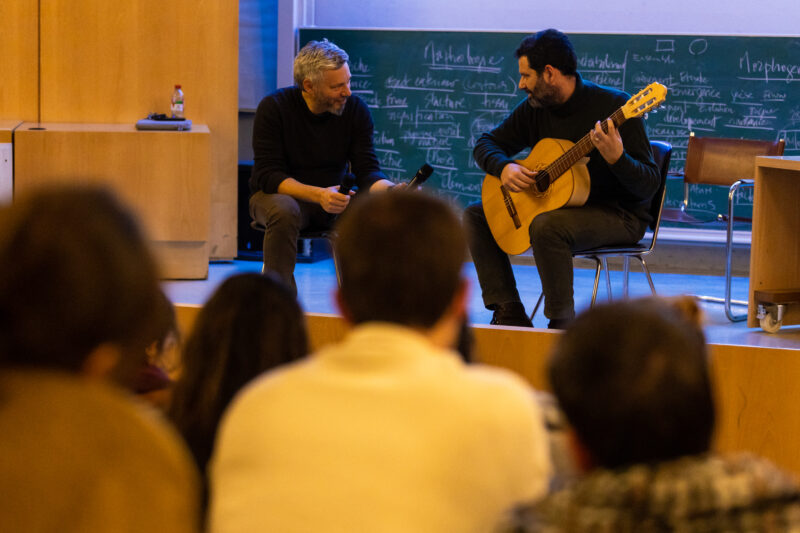
Lazaros Mavromatidis compares the fingerings of « Fade to Black » by Metallica with an alternative fingering for Johann Sebastian Bach’s « BWV 995 Gavotte I & II » for lute, to illustrate how different approaches influence the sound and aesthetics of a classical musical piece.
Additionally, Lazaros Mavromatidis‘s lecture exposed several profound reflections on how we conceive and experience architectural spaces. He posed crucial questions about the ability to meticulously design a sense of deep immersion through the auditory medium. He explored how synesthetic encounters and the complex interaction of auditory perceptions contribute to the formation of our complex spatial imagination. He also examined the nuanced dimensions of silence, contemplating it philosophically as a fundamental architectural element.
Lazaros Mavromatidis questioned how an architect might skilfully unravel the enigmatic concept of the « architectural ear » to construct a deeply evocative place. Another key point of his lecture focused on the pedagogical tradition of architects, which involves designing spatial elements primarily rooted in visual imagery. He highlighted the potential of a more multisensory approach to architectural design, transcending this conventional paradigm by integrating sound more into the creative process. Lazaros Mavromatidis asserted that the essence of architectural exploration lies in the convergence of these questions: it is not merely about delineating spaces but orchestrating a multisensory opus that resonates at the core of environmental consciousness.

It is within this interaction of sensory modalities that architecture of exceptional resonance manifests through the centuries. This second lecture thus offered an enriching perspective on integrating auditory perceptions into architecture, encouraging participants to consider design methods that foster a more immersive and multisensory spatial experience.

To go beyond a mere theoretical demonstration, Lazaros Mavromatidis set up an innovative pedagogical experiment. He composed music and created an auditory support specially designed to accompany the narration of a classic excerpt from « Invisible Cities » by Italian writer Italo Calvino. He then asked the students to close their eyes and, without resorting to visual perception, to design a space solely by being guided by the combination of sounds, notes, and words from the auditory support.
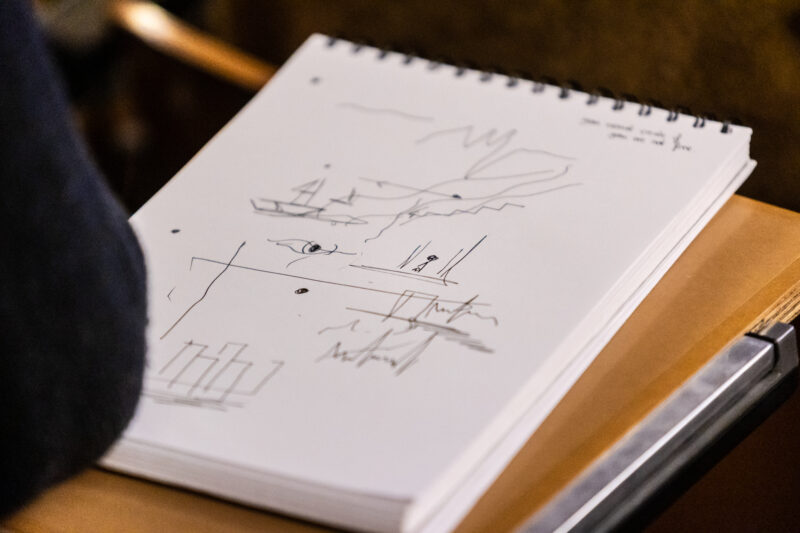
This experience brought the theoretical concepts discussed during this thematic day to life, stimulating the students’ imagination. It tangibly demonstrated how auditory perceptions can enrich spatial design, encouraging future architects to integrate multidimensional spatial qualities into their projects. This process not only illustrated the potential of audio in architectural creation but also allowed participants to experience total immersion, offering them a new perspective on how to perceive and design spaces. This pedagogical approach showed how sounds and words can profoundly influence and inspire architectural qualities, transcending the limits of conventional visual perception.

Subsequently, the two speakers conducted an architectural design workshop, during which they discussed the students’ projects in depth. They shared their perspectives and offered practical advice, encouraging the students to incorporate the concepts addressed into their own work. The day concluded with a mentoring session where Lazaros Mavromatidis and Alkinoos Ioannides helped the students develop and refine their projects, putting into practice the ideas explored during the thematic day.
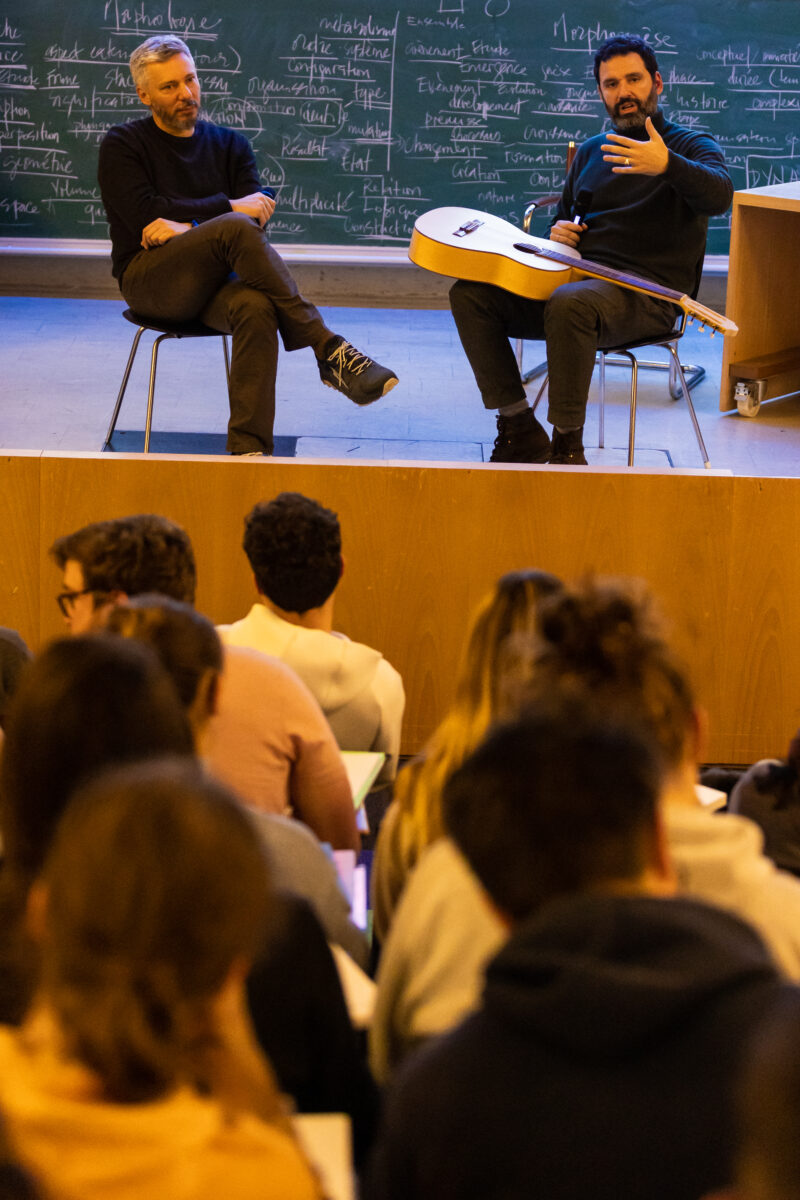
This approach allowed the students to benefit from personalized guidance and to transform their theoretical visions into concrete realizations. The workshop also provided a platform for constructive exchanges, reinforcing the understanding and application of multisensory design concepts in architecture.
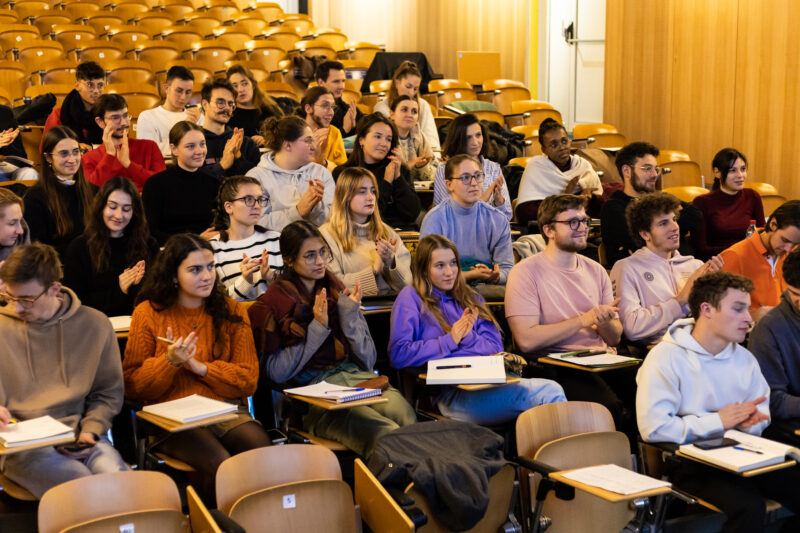
The thematic day proved to be an enriching experience, integrating theory and practice, and leaving the students inspired and better equipped to approach their future architectural projects with a more holistic and innovative perspective.
ABOUT OUR GUEST

Alkinoos Ioannides
Alkinoos Ioannides, born in Nicosia, Cyprus, is a distinguished singer-songwriter, composer, and performer. He studied classical guitar at the European Conservatory before moving to Athens in 1989, where he studied theatre and philosophy. Signing with Universal Music in 1993, Ioannides has released eleven solo albums, achieving gold or platinum status, and collaborated on over 40 albums. His diverse musical influences include traditional Cypriot music, Byzantine, classical, rock, and Greek composers. Ioannides performs with a band or solo, incorporating rock, jazz, classical, Greek, and Middle Eastern influences in his live shows, which span venues from ancient amphitheatres to modern rock stages. He studied composition with Russian composer Boris Tishchenko and has had his symphonic work performed by prestigious orchestras globally. His theatre work includes primary roles at the ancient theatre of Epidaurus and compositions for theatre in multiple countries. Ioannides also performs with the avant-garde group FMS and have served on the board of the Athens Concert Hall. He conducts annual creative writing seminars and has performed over 1,700 concerts in Greece and Cyprus, and 100 abroad.
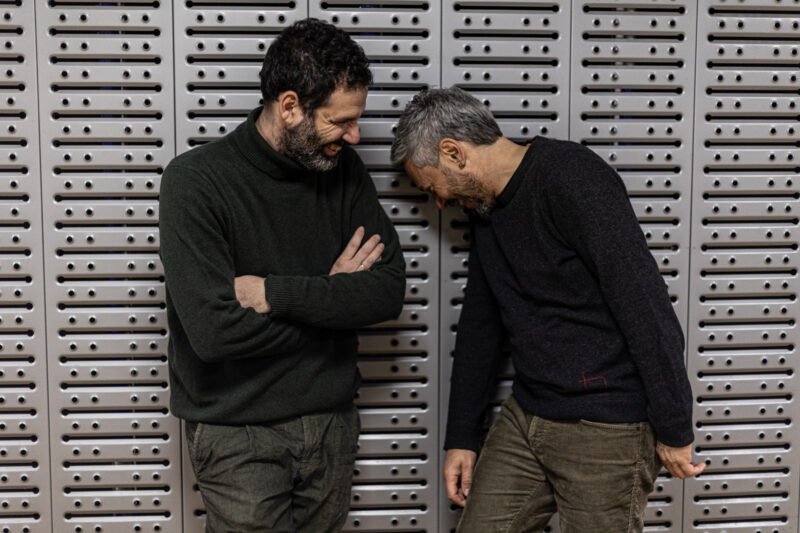
NB : All photos have been taken by the architect-photographer Michel Grasso. It is strictly prohibited to use, share, or disseminate any photos from this event without the explicit permission of the photographer and the individuals depicted in the photos. This includes but is not limited to any digital or physical reproductions, publications, or public sharing on any platform. Respect for individuals’ rights to their own image and the creative rights of the photographer is of paramount importance for the School of Architecture of INSA Strasbourg, and any unauthorized use will be considered a breach of privacy and copyright. Permission must be sought and granted from all relevant parties before any use of these photos.
_____________________________________________________________________________________________________________


